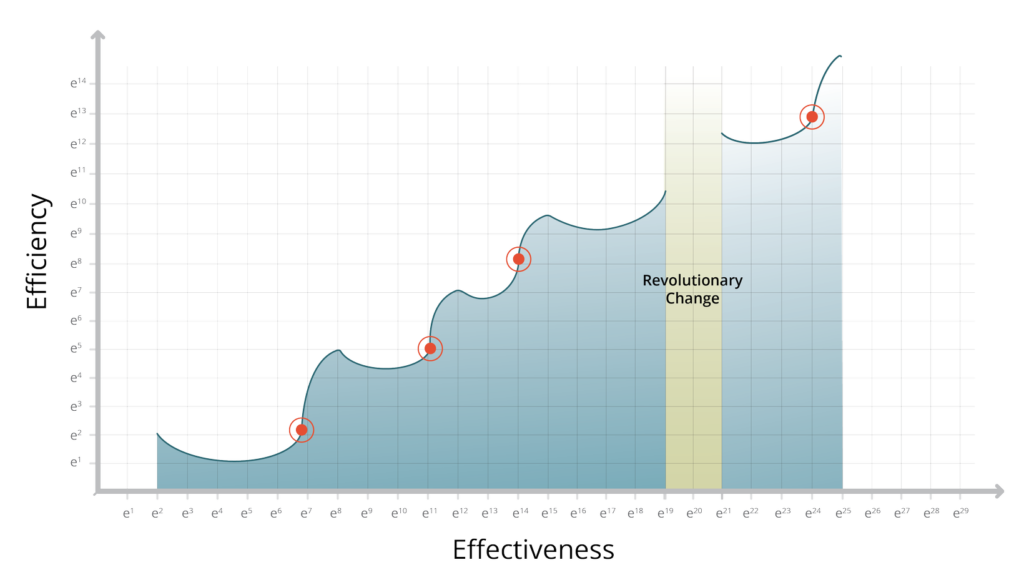Change is constant. If we fail to adapt by not constantly improving how we deliver value, we won’t succeed. A key distinction for improvement is the difference between effectiveness and efficiency. These two concepts need to be approached separately. Often people try to address both at the same time, which results in neither being done well.
- Effectiveness is about getting an improved result.
- Efficiency is about getting those results faster or with less effort without compromising effectiveness.
It is essential to be effective before you are efficient. For example, a car is effective when it gets you from point A to point B, the desired result of driving. An example of a car’s efficiency is its fuel consumption. But when you can’t get to your desired destination, your miles per gallon doesn’t matter. If you create a car that offers great mileage but doesn’t get you where you want to go, no one will buy it.
It’s essential to be effective before you’re efficient. A car is effective when it gets you from point A to point B…a car’s efficiency is measured by its fuel consumption. But when you can’t get to your desired destination, miles per gallon doesn’t matter.
Effectiveness and efficiency each are on a continuum; you can always get better. The costs of improving both increase exponentially – e.g., in the car example getting from point A to B safer and safer or increasing fuel economy more and more. Therefore, we need to consider the concept of being “effective enough.” You need to focus first on being “effective enough” at getting the desired result. Only after you’ve achieved the desired level of effectiveness can you focus on being efficient. When focusing on efficiency, you need to make sure you aren’t decreasing your effectiveness.
Over time, market forces and competition drive “effective enough” to higher levels. Even though you are as effective as you have always been, you are no longer “effective enough.” This means you once again need to shift your focus back to effectiveness and put efficiency on the backburner, but only temporarily. Focusing on effectiveness will also often decrease efficiency, because it takes extra effort to learn new skills and approaches.
So, how do you know when you are “effective enough”? This is a strategy question. Generally, you want to be slightly above the market so that your “effective enough” is better than your competition’s, but not so much above that you price yourself out of the market. Another approach is to be just below the market and have lower prices than your competition. Either way, you need to balance the cost of higher levels of effectiveness with what the market demands.
When starting out, you may need to boost your effectiveness, which forces you to sacrifice efficiency to achieve the appropriate level. Once achieved, you may switch back to improve efficiency. These back-and-forth shifts in focus from effectiveness to efficiency result in a zig-zag pattern. They continuously improve your levels of effectiveness and efficiency but do so with diminishing returns. As time passes, improving effectiveness and efficiency becomes increasingly more difficult.
So, how do you know when you are effective enough? That is a strategy question.
As improvement becomes more difficult, the opportunity arises for strategic disruption and a revolutionary change. The challenge with revolutionary change is that it generally requires a temporary setback in either or both effectiveness and efficiency. Revolutionary changes, therefore, need to be considered carefully and done with awareness of their impact. The opportunity for revolutionary change generally surfaces after a brief setback, as you develop new levels of effectiveness and/or efficiency.

In software product development, effectiveness is about delivering value to end users. It is about having end users move from trust to loyalty and, ultimately, to advocacy in your product. This means you need to measure your effectiveness. You need to focus on being “effective enough” to generate sufficient usage and user advocacy to advance your product. Once you have attained this usage level, then you can focus on being more efficient: e.g., optimizing delivery times, reducing costs per feature, etc. After a period of time, “effective enough” has changed – users’ expectations change from competition or other experiences, and you need to focus back on effectiveness.
The first question to ask yourself is: am I “effective enough?” At ITX, we have developed a model we call product momentum that helps you answer this question. By completing checklists around each of the four components that make up momentum, you begin to see evidence that suggests you aren’t being effective. You then match your effectiveness assessment to product KPIs to drive the ultimate number of users who are displaying trust, loyalty, and advocacy behaviors when interacting with your product.
In summary, the first question to ask is, am I “effective enough”? If not, you should subjugate efficiency to get effectiveness. By starting with effectiveness and delivering the desired results, you can move to efficiency and deliver that result faster and with less effort and cost. By separating these two concepts, you keep your team focused and therefore generate results faster than if you try to do both at the same time.



